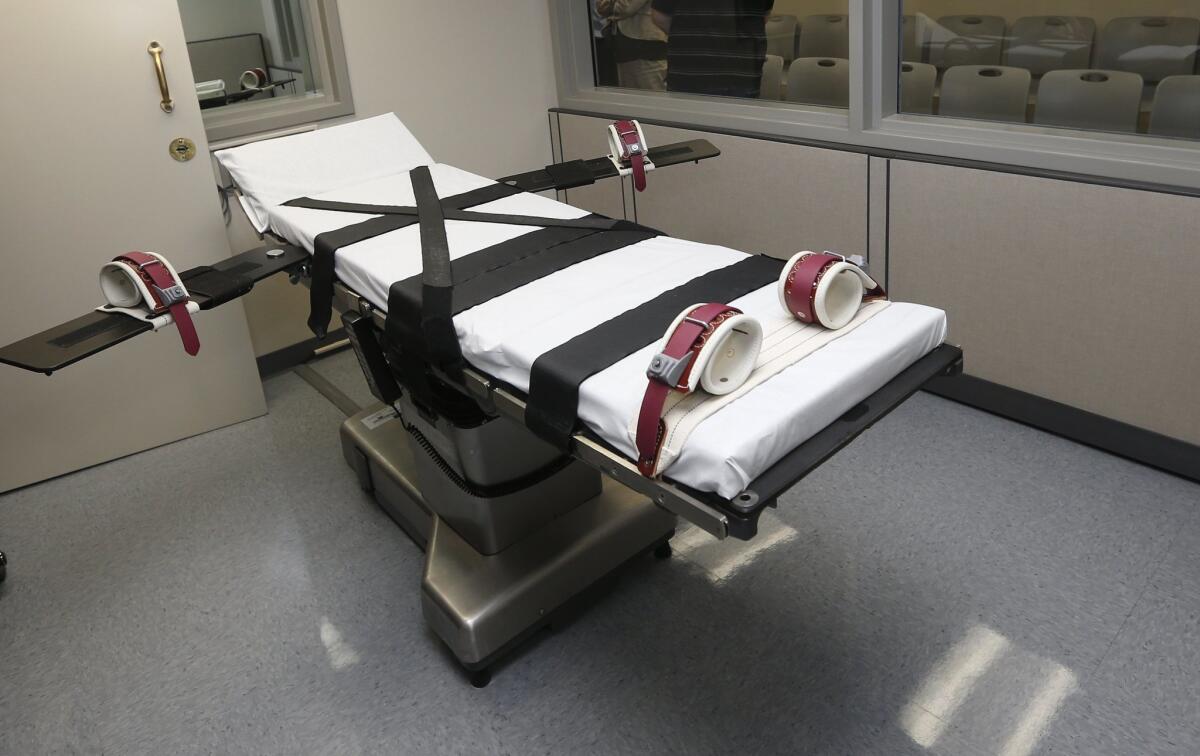Q&A: What’s next after Supreme Court agrees to review execution protocols?

- Share via
The U.S. Supreme Court has agreed to hear a challenge to Oklahoma’s procedures on executing death row inmates, an action that opens the door to a ruling on how executions are handled across the nation.
The court’s action comes after a year in which convicted murderers executed in Oklahoma, Arizona and Ohio appeared to suffer and took many minutes to die. In response, death penalty opponents went to court, asking judges to halt executions and to review the procedures used to carry them out. The executions also prompted supporters of capital punishment to suggest that states return to older methods of putting people to death.
The Supreme Court has ruled the death penalty constitutional, but questions remain about the methods used to carry it out. Here is a primer to understanding the issues involved.
What did the Supreme Court do?
The nation’s top court decided that it would consider a challenge from three Oklahoma inmates who argue that the procedure and drugs used in lethal injections violate the U.S. Constitution’s ban on cruel and unusual punishment.
It appears that four judges, the liberal wing of the court, voted to take up the issue even though the five-jurist conservative majority had approved an execution in Oklahoma on Jan. 15. It takes only four of the nine justices to agree to hear a case.
Why now?
Some of the justices have been eager to act after a year in which three executions in three states had serious problems, with inmates seeming to suffer while being put to death. In recent years, many states have had to scramble and change their procedures because they have had problems finding a supply of the right drugs.
What is the legal issue? Is it just a question of pain?
The 8th Amendment to the Constitution prohibits cruel and unusual punishment, but exactly what that means is always open to interpretation. When the Supreme Court in 2008 last looked at lethal injections, Chief Justice John G. Roberts Jr. wrote that it takes more than pain to violate the Constitution.
“Simply because an execution method may result in pain, either by accident or as an inescapable consequence of death, does not establish the sort of ‘objectively intolerable risk of harm’ that qualifies as cruel and unusual,” the justice wrote.
Does the current case have ramifications beyond Oklahoma?
The Supreme Court potentially could decide the national standards for the use of lethal injection, the primary method of execution used by the states and the federal government.
Right now the procedures vary. Many states use a three-drug combination with three injections: an anesthetic or sedative, followed by pancuronium bromide to paralyze the inmate, then potassium chloride to stop the heart. However, some states use a one- or two-drug combination that usually includes a lethal dose of an anesthetic or sedative.
How did we get to this point?
Before 2008, death-penalty states used sodium thiopental to induce unconsciousness.But the U.S. manufacturer of sodium thiopental stopped making the drug, and the European Union, where capital punishment is banned, prohibited the export of the drug to stop it from being used in U.S. executions. That meant that states had to find substitutes. Pentobarbital was used extensively, but its producer also objected to its use for executions.
As supplies of pentobarbital dwindled, states considered alternatives, including turning back to older methods, such as gas chambers. Oklahoma and other states turned to the drug midazolam.
Is there a problem with midazolam?
Opponents of the death penalty say yes.
“The drug protocol used in Oklahoma is not capable of producing a humane execution, even if it is administered properly,” said Dale Baich, one of the attorneys representing Oklahoma death row prisoners who brought the case to the Supreme Court. Three of the four states that use midazolam have had problems. Only Florida, the first state to use the drug, has not had a reported any difficulty.
Last April, Oklahoma executed Clayton Lockett, who witnesses said kicked his legs and grimaced before dying 43 minutes after the lethal injection began. A state investigation found problems with the way the execution team inserted the needle.
Oklahoma revamped its procedures, including a fivefold increase in the amount of midazolam. It used the new procedures to put Charles Warner to death earlier this month without incident.
Ohio had used midazolam months before Lockett was put to death, and the inmate in that execution, Dennis McGuire, gasped and choked before taking about 25 minutes to die. Last July in Arizona, Joseph R. Wood gasped and snorted for more than 90 minutes before he died. Arizona and Ohio have said they won’t use midazolam and other drug mixtures again.
What does Oklahoma say about the Supreme Court’s action?
“Oklahoma’s execution protocol has been affirmed as constitutional by two federal courts,” Oklahoma Atty. Gen. Scott Pruitt stated on Friday. “We will continue to defend the constitutionality of this protocol in order to preserve [the Department of Corrections’] ability to proceed with the sentences that were given to each inmate by a jury of their peers.”
What happens next?
The three death row inmates will ask for stays of execution, and will probably receive them. Prisoners in other states will also seek delays while the court hears arguments, probably in April, and issues a ruling, expected by June.
For national news follow @LATimesmuskal
More to Read
Sign up for Essential California
The most important California stories and recommendations in your inbox every morning.
You may occasionally receive promotional content from the Los Angeles Times.











